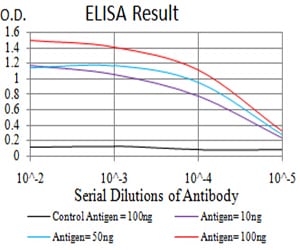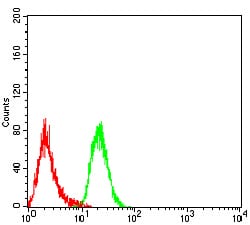

| WB | 咨询技术 | Human,Mouse,Rat |
| IF | 咨询技术 | Human,Mouse,Rat |
| IHC | 咨询技术 | Human,Mouse,Rat |
| ICC | 技术咨询 | Human,Mouse,Rat |
| FCM | 1/200 - 1/400 | Human,Mouse,Rat |
| Elisa | 1/10000 | Human,Mouse,Rat |
| Aliases | LGP2; RLR-3; D11LGP2; D11lgp2e |
| Entrez GeneID | 79132 |
| clone | 6A6A3 |
| WB Predicted band size | 76.6kDa |
| Host/Isotype | Mouse IgG2b |
| Antibody Type | Primary antibody |
| Storage | Store at 4°C short term. Aliquot and store at -20°C long term. Avoid freeze/thaw cycles. |
| Species Reactivity | Human |
| Immunogen | Purified recombinant fragment of human DHX58 (AA: 479-678) expressed in E. Coli. |
| Formulation | Purified antibody in PBS with 0.05% sodium azide |
+ +
以下是关于DHX58(LGP2)抗体的参考文献及其摘要概括:
---
1. **"DHX58/LGP2 participates in innate immune response to virus infection by regulating RIG-I signaling"**
**作者**: Venkataraman T, et al. (2007)
**摘要**: 本研究探讨了DHX58/LGP2在抗病毒天然免疫中的作用,利用特异性抗体通过Western blot和免疫共沉淀技术,证实LGP2通过调控RIG-I和MDA5的信号通路增强抗病毒干扰素反应。
2. **"The RNA helicase Lgp2 inhibits TLR-independent sensing of viral replication by retinoic acid-inducible gene-I"**
**作者**: Rothenfusser S, et al. (2005)
**摘要**: 文章通过免疫荧光和抗体介导的功能抑制实验,发现LGP2(DHX58)负调控RIG-I对病毒复制的识别,揭示了其在平衡抗病毒反应中的关键作用。
3. **"Regulation of antiviral innate immune responses by RIG-I family RNA helicases"**
**作者**: Yoneyama M, et al. (2005)
**摘要**: 该研究系统综述了RIG-I家族蛋白(包括LGP2/DHX58)在识别病毒RNA中的机制,并利用特异性抗体验证了LGP2在信号转导中的结构功能及其与MDA5的相互作用。
4. **"Structural basis for cytosolic double-stranded RNA surveillance by human oligoadenylate synthase 1"**
**作者**: Bruns AM, et al. (2014)
**摘要**: 研究结合X射线晶体学和抗体标记技术,分析了LGP2(DHX58)的RNA结合结构域,揭示了其在识别病毒RNA中的分子机制,并验证了抗体在蛋白质定位中的应用。
---
这些文献均涉及DHX58抗体的实验应用(如Western blot、免疫共沉淀、免疫荧光等),并探讨了其在天然免疫、信号调控及结构研究中的功能。
The DHX58 antibody is a research tool designed to detect and study DHX58. a protein encoded by the *DHX58* gene, also known as **LGP2** (Laboratory of Genetics and Physiology 2). As a member of the RIG-I-like receptor (RLR) family, DHX58 plays a critical role in innate antiviral immunity by sensing viral RNA and regulating downstream signaling pathways. Unlike other RLRs (e.g., RIG-I and MDA5), DHX58 lacks caspase activation and recruitment domains (CARDs), suggesting a unique regulatory function in modulating immune responses. It acts as both a positive and negative regulator, enhancing antiviral signaling in some contexts while dampening excessive interferon (IFN) production to prevent immune pathology.
DHX58 antibodies are widely used in immunological and virological research to investigate protein expression, localization, and interactions in various cell types. Applications include Western blotting, immunofluorescence, and immunoprecipitation to explore DHX58's role in viral infections (e.g., influenza, SARS-CoV-2), autoimmune diseases, and cancer. Studies also employ these antibodies to dissect its interplay with signaling molecules like MAVS, TBK1. and IRF3. shedding light on mechanisms underlying antiviral defense and immune homeostasis. Commercial DHX58 antibodies are typically validated for specificity and sensitivity across human, mouse, or other model organisms, supporting translational research in infectious and inflammatory diseases.
×